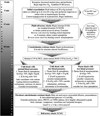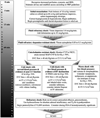Clinical practice parameters for hemodynamic support of pediatric and neonatal septic shock: 2007 update from the American College of Critical Care Medicine
- PMID: 19325359
- PMCID: PMC4447433
- DOI: 10.1097/CCM.0b013e31819323c6
Clinical practice parameters for hemodynamic support of pediatric and neonatal septic shock: 2007 update from the American College of Critical Care Medicine
Erratum in
- Crit Care Med. 2009 Apr;37(4):1536. Skache, Sara [corrected to Kache, Saraswati]; Irazusta, Jose [corrected to Irazuzta, Jose]
Abstract
Background: The Institute of Medicine calls for the use of clinical guidelines and practice parameters to promote "best practices" and to improve patient outcomes.
Objective: 2007 update of the 2002 American College of Critical Care Medicine Clinical Guidelines for Hemodynamic Support of Neonates and Children with Septic Shock.
Participants: Society of Critical Care Medicine members with special interest in neonatal and pediatric septic shock were identified from general solicitation at the Society of Critical Care Medicine Educational and Scientific Symposia (2001-2006).
Methods: The Pubmed/MEDLINE literature database (1966-2006) was searched using the keywords and phrases: sepsis, septicemia, septic shock, endotoxemia, persistent pulmonary hypertension, nitric oxide, extracorporeal membrane oxygenation (ECMO), and American College of Critical Care Medicine guidelines. Best practice centers that reported best outcomes were identified and their practices examined as models of care. Using a modified Delphi method, 30 experts graded new literature. Over 30 additional experts then reviewed the updated recommendations. The document was subsequently modified until there was greater than 90% expert consensus.
Results: The 2002 guidelines were widely disseminated, translated into Spanish and Portuguese, and incorporated into Society of Critical Care Medicine and AHA sanctioned recommendations. Centers that implemented the 2002 guidelines reported best practice outcomes (hospital mortality 1%-3% in previously healthy, and 7%-10% in chronically ill children). Early use of 2002 guidelines was associated with improved outcome in the community hospital emergency department (number needed to treat = 3.3) and tertiary pediatric intensive care setting (number needed to treat = 3.6); every hour that went by without guideline adherence was associated with a 1.4-fold increased mortality risk. The updated 2007 guidelines continue to recognize an increased likelihood that children with septic shock, compared with adults, require 1) proportionally larger quantities of fluid, 2) inotrope and vasodilator therapies, 3) hydrocortisone for absolute adrenal insufficiency, and 4) ECMO for refractory shock. The major new recommendation in the 2007 update is earlier use of inotrope support through peripheral access until central access is attained.
Conclusion: The 2007 update continues to emphasize early use of age-specific therapies to attain time-sensitive goals, specifically recommending 1) first hour fluid resuscitation and inotrope therapy directed to goals of threshold heart rates, normal blood pressure, and capillary refill <or=2 secs, and 2) subsequent intensive care unit hemodynamic support directed to goals of central venous oxygen saturation >70% and cardiac index 3.3-6.0 L/min/m.
Conflict of interest statement
The remaining authors have not disclosed any potential conflicts of interest.
Figures


Comment in
-
Pediatric sepsis: time is of the essence.Crit Care Med. 2009 Feb;37(2):785-6. doi: 10.1097/CCM.0b013e3181931210. Crit Care Med. 2009. PMID: 19325390 No abstract available.
-
Pediatric septic shock guidelines and extracorporeal membrane oxygenation management.Crit Care Med. 2009 Jun;37(6):2143-4; author reply 2144-5. doi: 10.1097/CCM.0b013e3181a5c33c. Crit Care Med. 2009. PMID: 19448486 No abstract available.
-
Norepinephrine in fluid-refractory catecholamine-resistant cold shock: are we sure?Crit Care Med. 2009 Jul;37(7):2322-3; author reply 2323. doi: 10.1097/CCM.0b013e3181a9f84c. Crit Care Med. 2009. PMID: 19535935 No abstract available.
-
Comment on the 2007 American College of Critical Care Medicine clinical guidelines for management of pediatric and neonatal septic shock.Crit Care Med. 2009 Jul;37(7):2324-5; author reply 2325. doi: 10.1097/CCM.0b013e3181aabc7c. Crit Care Med. 2009. PMID: 19535939 No abstract available.
-
Pediatric septic shock: let's talk about blood pressure.Crit Care Med. 2009 Dec;37(12):3190; author reply 3190-1. doi: 10.1097/CCM.0b013e3181bcb445. Crit Care Med. 2009. PMID: 19923954 No abstract available.
-
Epinephrine in pediatric septic shock: does the algorithm speak what the recommendations say?Crit Care Med. 2010 Apr;38(4):1237-8; author reply 1238. doi: 10.1097/CCM.0b013e3181d3ad7c. Crit Care Med. 2010. PMID: 20335731 No abstract available.
Similar articles
-
Clinical practice parameters for hemodynamic support of pediatric and neonatal patients in septic shock.Crit Care Med. 2002 Jun;30(6):1365-78. doi: 10.1097/00003246-200206000-00040. Crit Care Med. 2002. PMID: 12072696 Review.
-
American College of Critical Care Medicine Clinical Practice Parameters for Hemodynamic Support of Pediatric and Neonatal Septic Shock.Crit Care Med. 2017 Jun;45(6):1061-1093. doi: 10.1097/CCM.0000000000002425. Crit Care Med. 2017. PMID: 28509730
-
[Clinical practice parameters for hemodynamic support of pediatric and neonatal patients in septic shock].J Pediatr (Rio J). 2002 Nov-Dec;78(6):449-66. J Pediatr (Rio J). 2002. PMID: 14647725 Portuguese.
-
A synopsis of 2007 ACCM clinical practice parameters for hemodynamic support of term newborn and infant septic shock.Early Hum Dev. 2014 Mar;90 Suppl 1:S45-7. doi: 10.1016/S0378-3782(14)70015-5. Early Hum Dev. 2014. PMID: 24709458 Review.
-
Time- and fluid-sensitive resuscitation for hemodynamic support of children in septic shock: barriers to the implementation of the American College of Critical Care Medicine/Pediatric Advanced Life Support Guidelines in a pediatric intensive care unit in a developing world.Pediatr Emerg Care. 2008 Dec;24(12):810-5. doi: 10.1097/PEC.0b013e31818e9f3a. Pediatr Emerg Care. 2008. PMID: 19050666
Cited by
-
Statistical analysis plan for the SQUEEZE trial: A trial to determine whether septic shock reversal is quicker in pediatric patients randomized to an early goal-directed fluid-sparing strategy vs. usual care (SQUEEZE).Crit Care Resusc. 2024 Jun 22;26(2):123-134. doi: 10.1016/j.ccrj.2024.02.002. eCollection 2024 Jun. Crit Care Resusc. 2024. PMID: 39072232 Free PMC article.
-
Fluid resuscitation in children with severe infection and septic shock: a systematic review and meta-analysis.Eur J Pediatr. 2024 Sep;183(9):3925-3932. doi: 10.1007/s00431-024-05653-w. Epub 2024 Jun 25. Eur J Pediatr. 2024. PMID: 38916738
-
ExtraCorporeal Membrane Oxygenation in the therapy for REfractory Septic shock with Cardiac function Under Estimated (ECMO-RESCUE): study protocol for a prospective, multicentre, non-randomised cohort study.BMJ Open. 2024 Jun 10;14(6):e079212. doi: 10.1136/bmjopen-2023-079212. BMJ Open. 2024. PMID: 38858161 Free PMC article.
-
Lactate dynamics in paediatric patients with severe sepsis: insights from a prospective cohort study.BMC Pediatr. 2024 May 18;24(1):345. doi: 10.1186/s12887-024-04809-9. BMC Pediatr. 2024. PMID: 38760748 Free PMC article.
-
Sepsis-Induced Myocardial Dysfunction in Pediatric Septic Shock: Prevalence, Predictors, and Outcome-A Prospective Observational Study.J Pediatr Intensive Care. 2021 Nov 25;13(1):87-94. doi: 10.1055/s-0041-1736550. eCollection 2024 Mar. J Pediatr Intensive Care. 2021. PMID: 38571983 Free PMC article.
References
-
- DuPont HL, Spink WW. Infections due to gram negative organisms: An analysis of 860 patients with bacteremia at University of Minnesota Medical Center. 1958–1966. Medicine. 1969;48:307–332. - PubMed
-
- Stoll BJ, Holman RC, Shuchat A. Decline in sepsis-associated neonatal and infant deaths 1974–1994. Pediatrics. 1998;102:e18. - PubMed
-
- Angus DC, Linde Zwirble WT, Liddicker J, et al. Epidemiology of severe sepsis in the U.S.: Analysis of incidence, outcome, and associated costs of care. Crit Care Med. 2001;29:1303–1310. - PubMed
-
- Watson RS, Carcillo JA, Linde-Zwirble WT, et al. The epidemiology of severe sepsis in the United States. Am J Respir Crit Care Med. 2003;167:695–701. - PubMed
-
- Carcillo JA, Fields AI. American College of Critical Care Medicine Task Force Committee Members: Clinical practice parameters for hemodynamic support of pediatric and neonatal patients in septic shock. Crit Care Med. 2002;30:1365–1378. - PubMed
Publication types
MeSH terms
Grants and funding
LinkOut - more resources
Full Text Sources
Other Literature Sources
Medical

